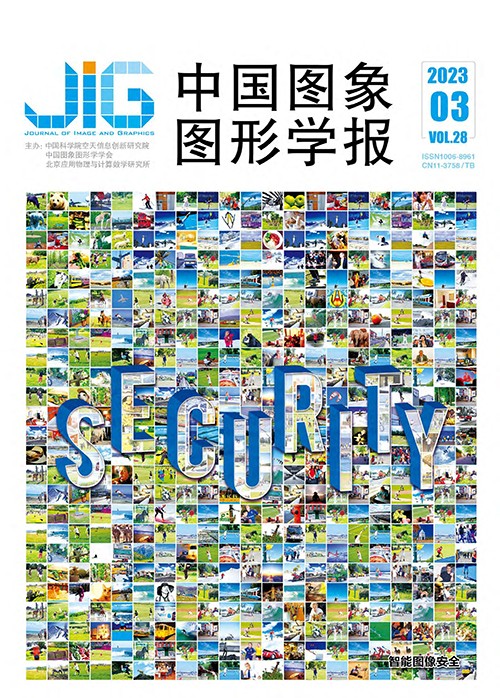
全体变长编码映射的JPEG可逆信息隐藏
王可1,2,3, 吴绍武1,2,3, 尹晓琳1,2,3, 付婧巧1,2,3, 陈兵1,2,3, 卢伟1,2,3(1. 中山大学计算机学院, 广州 510006;2. 摘 要
目的 JPEG(joint photographic experts group)作为一种广泛使用的图像格式,对其进行可逆信息隐藏有实际应用价值。大多数以JPEG图像为载体的可逆信息隐藏方案会导致图像质量降低和文件膨胀。由于在JPEG比特流中,并没有使用较多的变长编码(variable-length code,VLC),因此以未使用的VLC替换已使用的VLC可以实现秘密信息的无损嵌入,但这类方法的嵌入容量有限,且会导致文件膨胀。为了实现更大的嵌入容量并更好地控制文件膨胀,本文提出了新的全体VLC映射方案。方法 首先,重排序原始比特流中的行程长度/幅值大小(run/size value,RSV),获得去除编码冗余的载体;然后,引入中间VLC的概念,根据VLC频数分布,确定使文件膨胀大小相对于嵌入载荷最小的最优中间VLC映射模型;接着,通过计算模拟嵌入下的文件膨胀大小,确定构建最优中间VLC映射所需的嵌入VLC和中间VLC集合;最后,根据最优中间VLC映射关系修改定义哈夫曼表和JPEG比特流实现秘密信息的嵌入。结果 实验在USC-SIPI数据库上与基于DCT(discrete cosine transform)系数修改和基于VLC映射的方法进行对比。相较于基于限长VLC映射的方法,对不同的载体图像,本文方法的嵌入容量有540倍较大提升。与现有的典型可逆信息隐藏方法相比,在相同的嵌入容量下,本文方法嵌入造成的文件膨胀大小明显降低。对QF(quality factor)为90的载体图像嵌入1.8×104比特的秘密信息,本文方法造成的文件膨胀最高可降低46%。实验结果验证了RSV重排序的有效性,且提出的最优中间VLC映射可以在提供较大嵌入容量的同时保持较小的文件膨胀。结论 本文提出全体变长编码映射的JPEG可逆信息隐藏方法,通过构建最优的中间VLC映射,可以保持载体图像不失真并提供较大嵌入容量,且使文件膨胀更小。
关键词
General variable-length code mapping relevant reversible data hiding in JPEG bitstream
Wang Ke1,2,3, Wu Shaowu1,2,3, Yin Xiaolin1,2,3, Fu Jingqiao1,2,3, Chen Bing1,2,3, Lu Wei1,2,3(1. School of Computer Science and Engineering, Sun Yat-sen University, Guangzhou 510006, China;2. Abstract
Objective Data hiding technique based secret data can be embedded into the cover images, and the certified receiver can extract it from the marked image. However, most of data hiding methods cannot restore the cover image after data extraction. Reversible data hiding (RDH) can be as a special sort of data hiding techniques to ensure the complete recovery of the cover image and the secret data. Nowadays, JPEG is the most popular image format, which is widely used in diverse photography devices and the internet. JPEG images are commonly-used as the cover images of RDH. For the RDH schemes in joint photographic experts group (JPEG) images, the performance evaluations are focused on embedding capacity, visual quality, and file size increment of the marked image. One category of RDH in JPEG images is based on the variable-length code (VLC) mapping, which can preserve the visual quality of the marked image unchanged. Therefore, only the optimizations for embedding capacity and file size increment are required. Most previous methods based on VLC mapping prefer to improve the embedding capacity while keeping the file size unchanged. Although both the visual quality and the file size of the marked image will not be changed, the embedding capacity is rather limited. To achieve sufficient embedding capacity in terms of slight file size increment, we develop a new RDH method on the basis of general VLC mapping, which provides larger embedding capacity with smaller file size increment. Method To embed secret data, VLC mapping-based RDH methods replace the used VLCs with the unused VLCs in the bitstream. To get larger embedding capacity and smaller file size increment, we propose the mechanism of intermediate VLC mapping. First, the default defined Huffman table (DHT) is used to encode the DCT coefficients during JPEG compression. The run/size value (RSV) with higher frequency may be assigned to the VLC with longer code lengths. So before data embedding, RSV reordering is conducted first, and VLCs with shorter code lengths are allocated to RSVs with higher frequencies. After RSV reordering, coding redundancy is reduced and the VLC frequency distribution can be used to measure the performance of VLC mapping relationships. Next, we analyze the effect of intermediate VLC mapping and direct VLC mapping on the file size of the marked image. The intermediate VLC mapping will perform better than direct VLC mapping in terms of keeping the file size when the frequency of the selected intermediate VLC is less than the number of bits equal to 1 in the secret data. The optimal intermediate VLC mapping model is then proposed. To construct a map from the used VLC to the unused VLC and minimize the file size increment, the VLC with the smallest frequency is selected as the intermediate VLC for each code length. Finally, our method is employed to construct the optimal intermediate VLC mapping for the given embedding capacity and the JPEG bitstream. For secret data extraction, the certified receiver can reconstruct the VLC mapping without auxiliary information. Result The experiments are carried out on the USC-SIPI database. The embedding capacity is greatly improved by 5 to 40 for multiple cover images compared to previous VLC mapping-related RDH methods. When 1.8×104 bits of secret data are embedded in the cover JPEG images with quality factor 90, our file size increment can be reduced by up to 42%. The experiments have verified the effectiveness of RSV reordering as well. The proposed mapping can reduce the file size increment while a large embedding capacity is provided. Conclusion A new strategy is implemented to construct VLC mapping, called optimal intermediate VLC mapping. To realize RDH in JPEG bitstream, our method can keep the cover image unchanged, provide larger embedding capacity, and optimize smaller file size increment further.
Keywords
reversible data hiding(RDH) variable-length code(VLC) defined Huffman table(DHT) JPEG bitstream file size increment embedding capacity
|



 中国图象图形学报 │ 京ICP备05080539号-4 │ 本系统由
中国图象图形学报 │ 京ICP备05080539号-4 │ 本系统由